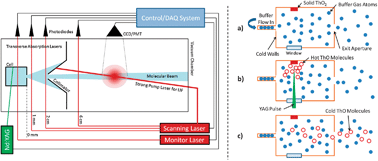A cryogenic beam of refractory, chemically reactive molecules with expansion cooling
Abstract
Cryogenically cooled

- This article is part of the themed collection: Physics and chemistry of cold molecules
* Corresponding authors
a
Harvard University Physics Department, 17 Oxford Street, Cambridge, USA
E-mail:
hutzler@physics.harvard.edu
Tel: +1 617 495 2713
b Yale University Physics Department, 217 Prospect Street, New Haven, USA
Cryogenically cooled

 Please wait while we load your content...
Something went wrong. Try again?
Please wait while we load your content...
Something went wrong. Try again?
N. R. Hutzler, M. F. Parsons, Y. V. Gurevich, P. W. Hess, E. Petrik, B. Spaun, A. C. Vutha, D. DeMille, G. Gabrielse and J. M. Doyle, Phys. Chem. Chem. Phys., 2011, 13, 18976 DOI: 10.1039/C1CP20901A
To request permission to reproduce material from this article, please go to the Copyright Clearance Center request page.
If you are an author contributing to an RSC publication, you do not need to request permission provided correct acknowledgement is given.
If you are the author of this article, you do not need to request permission to reproduce figures and diagrams provided correct acknowledgement is given. If you want to reproduce the whole article in a third-party publication (excluding your thesis/dissertation for which permission is not required) please go to the Copyright Clearance Center request page.
Read more about how to correctly acknowledge RSC content.
 Fetching data from CrossRef.
Fetching data from CrossRef.
This may take some time to load.
Loading related content
